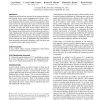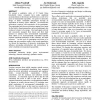CHI
2008
ACM
15 years 26 days ago
2008
ACM
In this paper we suggest the use of tangible user interfaces (TUIs) for human-robot interaction (HRI) applications. We discuss the potential benefits of this approach while focusi...
CHI
2008
ACM
15 years 26 days ago
2008
ACM
We evaluate two systems for automatically generating personalized interfaces adapted to the individual motor capabilities of users with motor impairments. The first system, SUPPLE...
CHI
2008
ACM
15 years 26 days ago
2008
ACM
Significant effort has been invested in developing expressive and flexible access-control languages and systems. However, little has been done to evaluate these systems in practic...
CHI
2008
ACM
15 years 26 days ago
2008
ACM
We present a qualitative study of 35 United States households whose occupants have made significant accommodations to their homes and behaviors in order to be more environmentally...
CHI
2008
ACM
15 years 26 days ago
2008
ACM
Coarse-grained approaches to customization allow the user to enable or disable groups of features at once, rather than individual features. While this may reduce the complexity of...
CHI
2008
ACM
2008
ACM
Employing patterns and layers for early-stage design and prototyping of cross-device user interfaces
15 years 26 days ago
Designing UIs that run across multiple devices is increasingly important. To address this, we have created a prototyping tool called Damask, which targets web UIs that run on PCs ...
CHI
2008
ACM
15 years 26 days ago
2008
ACM
Faceted browsing is a promising way to incrementally refine data sets. Current approaches do not scale well in terms of screen size and have shortcomings in interacting with hiera...
CHI
2008
ACM
15 years 26 days ago
2008
ACM
In the recent years, the number of individuals engaged in self-care of chronic diseases has grown exponentially. Advances in computing technologies help individuals with chronic d...
CHI
2008
ACM
15 years 26 days ago
2008
ACM
We present an empirical analysis of crossing-based dialog boxes. First, we study the spatial constraints required for efficient crossing-based interactions in the case of a simple...
CHI
2008
ACM
15 years 26 days ago
2008
ACM
Technologies in museums often support learning goals, providing information about exhibits. However, museum visitors also desire meaningful experiences and enjoy the social aspect...




